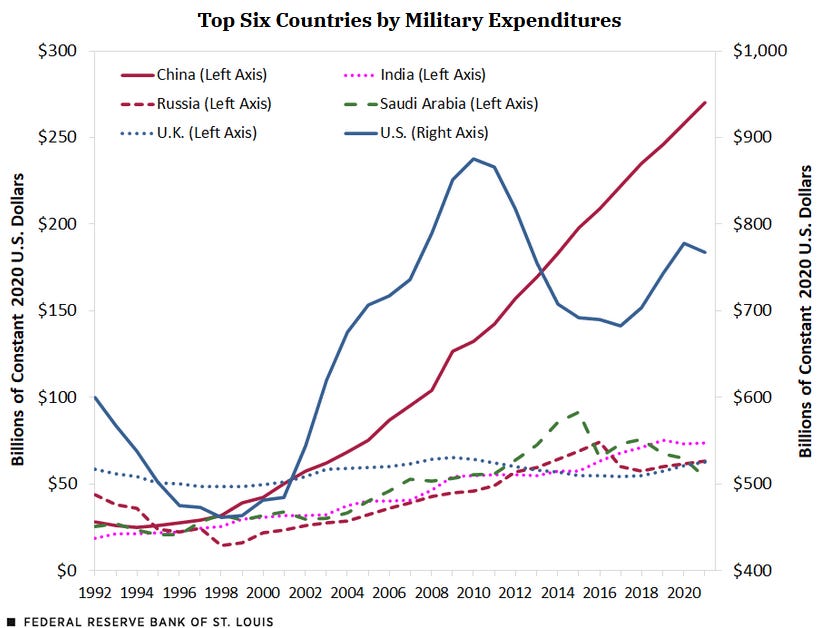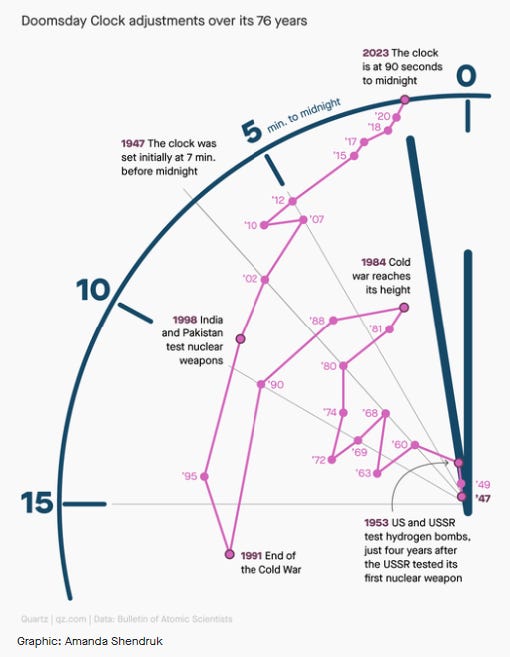Earthling: The China Derangement Syndrome
Plus: Lab-grown meat, dumbed down Doomsday Clock, Ukraine war endgames, Old-HatGPT, and more!
At first glance, the graph below looks like reason to worry about China’s military power. Upon closer examination it looks like reason to worry about America’s mental health.
The first glance would seem to indicate that Chinese military expenditures passed US military expenditures in 2013 and now greatly exceed them. A second appraisal—informed by the parenthetical explanations of which lines correspond to which vertical axis—indicates that the US is spending about three times as much on defense as China.
Oddly, this graph was produced and promoted by the Federal Reserve Bank of St. Louis. We say “oddly” because in theory the purpose of the 12 regional reserve banks is to regulate and oversee private banks—not to scare the nation into spending needlessly on defense, or for that matter to weigh in on matters of national defense at all. And for one of these banks to encourage, even obliquely, more defense spending seems only odder when you consider that the federal reserve system of which they’re part is America’s inflation fighter of last resort—and deficit spending is famously inflationary.
So why this graph? The St. Louis Fed blog post it was part of says that “it is useful to look at the patterns of defense spending around the world” because “the evolution of relative defense capabilities, among other factors, helps shape the course of the geopolitical balance of power.” The blog post doesn’t go on to explain why it’s the job of bank regulators to think about the geopolitical balance of power.
Are we overreacting to this graph? Probably. But somebody’s got to stay vigilant for signs that China Derangement Syndrome is reaching critical mass. Why not us?
We took comfort this week in finding that the Earthling isn’t alone in fretting about inflated fears of China. In an interview published in Wire China, Paul Heer, formerly the National Intelligence Officer for East Asia, worries that American policymakers have a cognitive empathy problem—a failure to understand how Beijing views the world—that leads them to overstate the Chinese threat.
America’s China strategy, Heer says, is premised on the idea that “we’re engaged in a struggle between autocracy and democracy for the future of the international order.” Heer thinks this framing “overstates China’s ambition. I don’t think the Chinese are trying to replace the current international order with a Sino-centric one. They’re trying to pursue multipolarity and international legitimacy for their system, not impose it on other countries.”
These Chinese aims, Heer emphasizes, do constitute “an ideological contest. But it’s not an existential contest—the Chinese aren’t trying to supplant American hegemony with Chinese hegemony and communize the world. They’re a big enough challenge without attributing that goal to them.”
As for why America suffers from this deficit in cognitive empathy—or, as Heer calls it, “strategic empathy”: For one thing, he says, the US is in relative decline, less far ahead of the pack than it used to be. The attendant sense of vulnerability leads it to see competition with China as neck and neck even though America is still top superpower by a long shot. In other words, our view of reality is distorted in exactly the way that St. Louis Fed graph encourages.
Heer detects a vicious circle here—a “classic security dilemma.” The US and China misperceive each other’s defense-minded actions as offensive and respond accordingly, fueling another round of misperception, and… and so on.
Heer says the Ukraine war may be a cautionary tale. “There’s a separate debate about what led to the war in Ukraine. But if there’s any element of truth that it was partly a product of Moscow’s view that US diplomacy in Europe excluded and targeted Russia, we need to be attentive to the perception in Beijing that our diplomacy in the Indo-Pacific excludes and targets China.” He notes that, ominously, “the Chinese have talked about the US trying to create an Asian NATO.”
Heer stresses that the US shouldn’t “be overly accommodative to Chinese interests and their own ambitions, which are profound—China does want to maximize its sphere of influence in East Asia relative to ours.” But maybe America should consider “an approach to multilateralism in East Asia that does not wholly exclude and target China.”
Performing that maneuver deftly will call for a clear understanding of Beijing’s mindset, and Heer admits that “strategic empathy is a hard thing to do.” And, to make it harder: Many Americans have a limited understanding of Chinese history and carry “ideological and Cold War baggage that prevents what I would call a more objective perception of what China represents.”
But there’s one encouraging sign. That graph of Chinese and US military expenditures got so much blowback that the St. Louis Fed issued a second tweet saying that “we regret the confusion this caused.”
“Cultivated meat”—grown from animal cells in giant steel vats—could make its way onto American menus this year, Reuters reports. In November, the US Food and Drug Administration paved the way by saying that a lab-grown chicken breast—or chicken “breast”—was safe to eat. The meat was made by UPSIDE Foods, a California-based company that hopes to see its products in restaurants this year and in grocery stores by 2028.
Now comes the marketing challenge. In one study, 35 percent of meat eaters and 55 percent of vegetarians said they considered lab-grown meat “too disgusting” to try. Companies like UPSIDE hope to win customers over by advertising that lab-grown meat is environmentally friendly and entails no animal suffering. (Suggested ad jingle: “More disgusting than something carved out of a corpse?”)
Former NZN creative director Nikita Petrov, now a Russian expat in Armenia, this week taped a Nonzero Podcast conversation about the state of things in Russia, Armenia, and elsewhere. That episode won’t air until next week, but we’re giving early access to paid subscribers, who can watch or listen to the conversation here.
This week the “Doomsday Clock”—which since 1947 has been periodically updated by the Bulletin of the Atomic Scientists to signify how close Earth is to apocalypse–ticked nearer to midnight than ever before.
No doubt Russia’s invasion of Ukraine has increased the chances of nuclear catastrophe. But some foreign policy experts are skeptical that Armageddon is closer than it was during, say, the Cuban Missile Crisis, when JFK and Nikita Khrushchev played a high-stakes game of nuclear chicken. Our Tweet of the Week, authored by one of those experts, offers a diagnosis of what went wrong with the Doomsday Clock.









